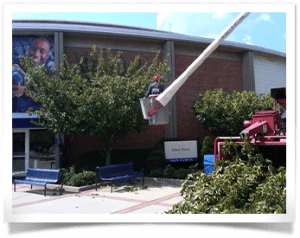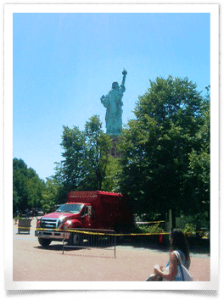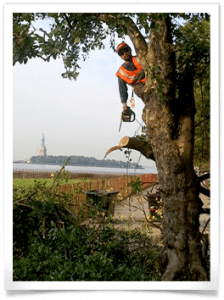Tree Pruning
- Home
- Tree Pruning
Tree Pruning and Shaping
When your trees need pruning, it can be tempting to try and remove the offending branches on your own. Your tree makeover efforts, however, may actually cause damage and even early tree death.
Tree pruning and shaping require years of experience and expertise to ensure strong and healthy trees. That’s why trees should only be pruned by Certified Tree Care Safety Professionals who practice safe and effective methods, like the experts at Friendly Tree.
 The Benefits of Proper Tree Pruning
The Benefits of Proper Tree Pruning
- Improves tree health: Removing dead and diseased branches takes a proactive approach to keeping insects and diseases from spreading throughout the tree.
- Improves aesthetics: Tree pruning and shaping is an art. Thoughtful pruning makes trees more attractive, and attractive trees add value to your home and property.
- Improves structure and form: Clearing away excess branches provides space for healthy growth. Thinning a tree’s canopy allows sun and air to pass through, enhancing the tree’s health and vitality.
- Reduces hazards: Dead or diseased branches are more than unsightly – they can cause serious damage to people and property if they come down during a storm.
- Helps trees grow strong: Taking steps to provide young trees with necessary pruning helps them develop into structurally strong trees that are well-suited for both their site and their intended functions.
 Tree pruning should start early. Trees younger than 25 years old need regular structural pruning to train their growth patterns and enhance and aid the aging process.
Tree pruning should start early. Trees younger than 25 years old need regular structural pruning to train their growth patterns and enhance and aid the aging process.
The goal of pruning mature trees is to maintain their health, appearance, structure and form. While all trees will gradually stop growing taller, they will continue to expand in girth and become more robust. Proper corrective pruning is vital to ensure the longevity of the tree.
Sometimes mature trees need training to bring them back to health. Pruning these trees should include hazard pruning and crown reduction or restoration to repair storm damage or correct crown dieback.
Not a DIY Project: Leave it to the Experts
Each cut is, essentially, a wound to the tree, which is why our arborists try to prune as little as possible to enhance the benefits and reduce the risks. Some trees require an aggressive pruning maintenance schedule, while others only need minor attention. Some can be pruned at any time, while others should only be pruned at specific times of the year.
For example, the black birch and its varieties should never be pruned in the winter. The wounds cause the tree to “bleed” to death as the sap runs uncontrollably, depleting the tree of nutrients and causing the tree’s death.
Tree pruning should be always be completed by a trained, certified arborist who has extensive experience pruning trees and understands what they need to thrive.
At Friendly Tree, we put safety first. Our Certified Tree Care Safety Professionals adhere to the ANSI A300 and ANSI Z133 standards for pruning methodology and safety practices. These industry standards, guided by the International Society of Arboriculture, set requirements for safe tree treatment, as well as workplace safety.
Pruning: The Art and Science of Tree Care
There are four primary levels of pruning, with different objectives and steps.
Class I: Fine Pruning
Fine pruning is primarily focused on the tree’s aesthetics, though it does improve the structure as well. Fine pruning is recommended for trees that need minor improvements.
- Crown cleaning removes dead, dying, diseased and broken branches that are at least one-half inch in diameter.
- Crown thinning reduces the density by taking out interfering, crossing or running branches, obstructing or weak branches, and water spouts. This helps to reduce the weight of the crown, improving structural integrity, and increasing the light penetration and air movement.
- Fine pruning may include crown raising and crown restoration, as needed.
 Class II: Standard Pruning
Class II: Standard Pruning
Standard pruning is ideal for general tree maintenance to improve the health and structural integrity of the tree.
- Crown cleaning removes dead, dying, diseased, decayed and broken branches that are at least one inch in diameter.
- Standard pruning may include crown raising and crown restoration, as needed.
Class III: Hazard Pruning
Hazard pruning is performed on trees that could pose a risk to nearby people and property.
- Crown cleaning removes the dead, dying, diseased and broken branches at least two inches in diameter.
- Hazard pruning may include crown raising and crown restoration, as needed.
Class IV: Crown Reduction
Crown reduction is used to reduce the height or spread of a tree, or both, for safety or aesthetic reasons. Crown reduction is primarily done on trees that have sustained significant crown dieback or storm damage, or to repair incorrect pruning.
Crown Reduction Crown reduction is recommended for trees that need a reduction in the size or spread of their crowns, or when the parent limb or dominant leader is removed at the point of attachment. It is also referred to as cutting back or drop-crotch pruning.
There is a difference between crown reduction – which is a healthy way to repair the entire canopy or individual limbs – and topping – which removes the entire top of the tree, including large branches. Topping leaves the tree without a terminal leader, or a trunk that emerges from the tree. Topping endangers the health and structural integrity of the tree, while crown reduction helps protect the tree’s overall health and strength.
Crown Restoration Trees at any level of pruning may require crown restoration and/or crown raising, both of which help to improve the tree’s health.
Crown restoration uses selective pruning to improve the tree’s structure, form and appearance, especially after undergoing storm damage, topping, or severely damaging pruning. It is not a one-time fix, and may require regular pruning applications over the course of several years to restore the tree’s health and achieve the desired results.
Crown raising is a practice that removes the lower branches to allow more space for traffic, open views, and better sunlight penetration. By targeting specific primary and secondary branches, crown raising can also be used to clear the way for new construction.
Need help determining if your tree needs pruning? We can help. For over 25 years we’ve been helping New Jersey residents with their tree care needs. Our certified arborists adhere to ANSI standards for tree care practices, with the expertise to help you assess what your trees need to stay happy and healthy.



